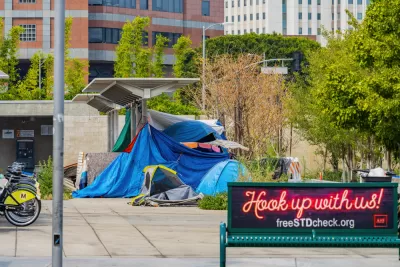An article by the L.A. Times earlier this week has raised the temperature of the debate about drug users and crime on rail transit. Concerns about public safety on transit are a common symptom of post-pandemic transit around the country.

“Since January, 22 people have died on Metro buses and trains, mostly from suspected overdoses — more people than all of 2022. Serious crimes — such as robbery, rape and aggravated assault — soared 24% last year compared with the previous,” according to an article by Rachel Uranga for the Los Angeles Times.
The article has been the talk of social media all week, with advocates and public officials weighing in on either side of the issue. The article suggests that ridership on the Los Angeles County Metropolitan Transportation Authority (Metro) is suffering as a result of the perceived public safety risks on the system—particularly on the system’s rail lines.
Commuters have abandoned large swaths of the Metro train system. Even before the pandemic, ridership in the region was never as high as other big-city rail systems. For January, ridership on the Gold Line was 30% of the pre-pandemic levels, and the Red Line was 56% of them.
Eventually, the article discusses the Ambassador Program, launched by metro at the beginning of March after being announced in June 2022:
In response to such concerns, transit officials committed $122 million over the last year trying to make the system — composed of 105 rail stations and more than 12,000 bus stops — feel safer by placing 300 unarmed “ambassadors” to report crimes and help passengers. It’s part of what officials like to tout as a “multilayered” approach to improving a system that’s become emptier and more dangerous over recent years — even as billions have been sunk into expansion of the rail lines.
The article also provides details about the fentanyl crisis in Los Angeles and the ongoing debate about how best to react. In the meantime, transit is in the midst of a crisis of multiple dimensions—with ridership, funding, policing, operator shortages, and public perception, just to name a few.
FULL STORY: L.A. riders bail on Metro trains amid ‘horror’ of deadly drug overdoses, crime

Planetizen Federal Action Tracker
A weekly monitor of how Trump’s orders and actions are impacting planners and planning in America.

Restaurant Patios Were a Pandemic Win — Why Were They so Hard to Keep?
Social distancing requirements and changes in travel patterns prompted cities to pilot new uses for street and sidewalk space. Then it got complicated.

Map: Where Senate Republicans Want to Sell Your Public Lands
For public land advocates, the Senate Republicans’ proposal to sell millions of acres of public land in the West is “the biggest fight of their careers.”

Maui's Vacation Rental Debate Turns Ugly
Verbal attacks, misinformation campaigns and fistfights plague a high-stakes debate to convert thousands of vacation rentals into long-term housing.

San Francisco Suspends Traffic Calming Amidst Record Deaths
Citing “a challenging fiscal landscape,” the city will cease the program on the heels of 42 traffic deaths, including 24 pedestrians.

California Homeless Arrests, Citations Spike After Ruling
An investigation reveals that anti-homeless actions increased up to 500% after Grants Pass v. Johnson — even in cities claiming no policy change.
Urban Design for Planners 1: Software Tools
This six-course series explores essential urban design concepts using open source software and equips planners with the tools they need to participate fully in the urban design process.
Planning for Universal Design
Learn the tools for implementing Universal Design in planning regulations.
Heyer Gruel & Associates PA
JM Goldson LLC
Custer County Colorado
City of Camden Redevelopment Agency
City of Astoria
Transportation Research & Education Center (TREC) at Portland State University
Camden Redevelopment Agency
City of Claremont
Municipality of Princeton (NJ)





























